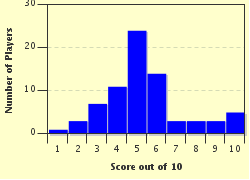Quiz Answer Key and Fun Facts
1. In what year was Auschwitz established?
2. How many satellite camps did Auschwitz have?
3. Prisoners were transported to Auschwitz by train. From March 1942 onwards, the new arrivals were segregated in a process known as 'selection'. What did it mean if you were sent to stand on the left side of the Selection Officer?
4. At what time did a prisoner's day begin?
5. Survivors have described their time in these concentration camps as "hell on Earth", so it's probably no surprise that some prisoners tried to escape. How many escape attempts from Auschwitz were successful?
6. Which of the following people survived their time in Auschwitz?
7. Although Jewish people were the main targets, which other groups were also targeted and sent to various concentrations camps?
8. Which gas was used in the Auschwitz gas chambers?
9. About how many people are thought to have died at Auschwitz?
10. When was Auschwitz liberated?
Source: Author
ElusiveDream
This quiz was reviewed by FunTrivia editor
bloomsby before going online.
Any errors found in FunTrivia content are routinely corrected through our feedback system.

